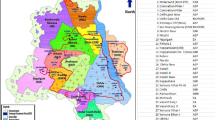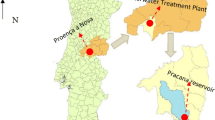Abstract
Biochemical Oxygen Demand (BOD) modeling in a river involves derivation and solution of the governing partial differential equation, which describes concentration change with time and space due to convection, dispersion, decay and the loading function. In this study, an analytical model is developed for BOD simulation for the boundary condition when the waste discharge concentration can be described a sinusoidal variation. The analytical model is obtained by solving the governing partial differential equation considering (i) the river for which BOD is uniformly distributed through any cross-section so that a one dimensional model is applicable and (ii) for specific initial and boundary conditions. The results of the model for BOD simulation validated for (i) water quality data from River Gomti in India, which is an important tributary of Ganga River with significant influx of pollutants, and (ii) the data sets used for validation of commonly used analytical models and are available in the published literature. The proposed model is found to represent the physical processes occurring in River Gomti with high correlation between observed and simulated BOD values. Moreover, the results obtained from other data sets published in the literature demonstrate the applicability of developed analytical model for BOD simulation.
Similar content being viewed by others
References
Adrian, D. D., Yu, F. X., and Barbe, D. (1994). “Water quality modeling for a sinusoidally varying waste discharge concentrations.” Water Research, Vol. 28, No.5, pp.1167–1174.
Adrian, D. D., Roider, E. M., and Sanders, T. G. (2004). “Oxygen Sag models for multiorder biochemical oxygen demand reactions.” Journal of Environ. Engrg., ASCE, Vol. 130, No.7, pp. 784–791.
Alshawabkeh, A. and Adrian, D. D. (1997). “Analytical water quality model for a sinusoidally varying BOD discharge concentration.” Water Research, Vol. 31, No.5, pp. 1207–1215.
Ambrose, R.B., Barnwell, T. O., McCutcheon, S. C., and Williams, J. R. (1996). Chapter 14: Computer models for water quality analysis. In: Water Resources Handbook, L.W. Mays, ed., McGraw-Hill, New York.
Bhargava, D. S. (1983). “Most rapid BOD assimilation in Ganga and Yamuna rivers.” Journal of Environ. Engrg., ASCE, Vol. 109, No.1, pp. 174–188.
Camp (1963). First expanded BOD-DO Model, Basic River Water Quality Models, IHP-V Project 8.1, Edited by D. G. Jolankai, 1997, pp. 27–29.
Dresnack, R. and Dobbins, W.E. (1968). “Numerical analysis of BOD and DO profiles.” J. Sanitary Engineering Division, Am. Soc. Civ. Engrs, Vol. 94(SA5), pp. 789–807.
Fair, G. M. (1939). “The dissolved oxygen sag-an analysis.” Sewage Works J., 11, p. 445
Gundelach, J. M. and Castillo, J. E., (1976). “Natural stream purification under anaerobic conditions.” J. Water Poll. Contr. Fed., Vol. 48, No.7, pp.1753–1758.
Jha, R. Ojha, C.S.P., and Bhatia, K.K.S. (2007). “Development of refined BOD and DO models for highly polluted Kali river in India.” Jr. of Environmental Engineering, ASCE, Vol. 133, No. 8, pp. 839–852.
Jolankai, G. (1997). Basic river water quality models, IHP-V, Technical documents in hydrology no. 13, UNESCO, Paris.
Koussis, A. D., Kokitar, P. and Menta, R. (1990). “Modelling DO concent-rations in streams with dispersion.” Jr. of Environmental Engineering, ASCE, Vol. 116, No. 3, pp. 601–614.
Li, W. H. (1962). “Unsteady dissolved-oxygen sag in a stream.” J. Saint. Engrg. Div., Am. Soc. Civ. Engrg., Vol. 88(SA3), pp. 75–85.
Li, W. H. (1972). “Effects of dispersion on DO-SAG in uniform flow.” J. Saint. Engrg. Div., Am. Soc. Civ. Engrg., Vol. 98(SA1), pp. 169–182.
Streeter, H. W. and Phelps, E. B. (1925). A study of the pollution and natural purification of the Ohio river, Public Health Bull, No. 146, Public Health Service, Washington DC, USA.
Theriault, E. J. (1927). The dissolved oxygen demand of polluted waters, Public Health Bulletin, No. 173, U. S. Public Health Service, Government Printing Office, Washington, D. C..Streeter, H. W., and Phelps, E. B. (1925). A study of the pollution and natural purification of the Ohio river, Public Health Bulletin, No. 146, Public Health Service, Washington, D.C.
Thomann, R.V. and Muller, J. A. (1987). Principles of surface water quality modelling and control, Harper and Row Publisher, New York.
Thomas, H.A. (1948). “Pollution load capacity of streams.” Wat. Sewage Wks, Vol. 95, No.11, p. 409.
Van Genuchten, M. T. and Alves, W. J. (1982). Analytical solutions of the one-dimensional convective-dispersive solute transport equation. Tech. Bull. 1661. U. S. Department of Agr., Agric. Res. Service.
Wang, C., Sun, N., and Yeh, W. W. (1986). “An upstream weight multiple-cell balance finite-element method for solving three-dimensional convection-dispersion equations.” Water Resour. Res., Vol. 22, No. 11, pp., 1575–1589.
Yeh, G. T. (1986). “An orthogonal-upstream finite element approach to modellling aquifer contaminant transport.” Water Resour. Res., Vol. 22, No. 6, pp. 952–964.
Yu, F. X., Adrian, D. D., and Singh P. (1991). “Modelling river quality by the superposition method.” J. Environ. Syst. Vol. 20, No. 1, pp., 1–16.
Author information
Authors and Affiliations
Corresponding author
Rights and permissions
About this article
Cite this article
Jha, R., Singh, V.P. Analytical water quality model for biochemical oxygen demand simulation in River Gomti of Ganga Basin, India. KSCE J Civ Eng 12, 141–147 (2008). https://doi.org/10.1007/s12205-008-0141-x
Published:
Issue Date:
DOI: https://doi.org/10.1007/s12205-008-0141-x




